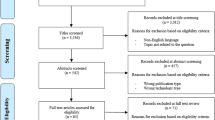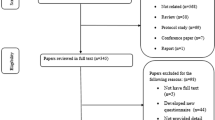Abstract
Studies on end-user adaptable applications for rehabilitation aim to offer exercises to patients based on their therapeutic goals and individual advances. The process of adapting the applications is usually done by therapists, who have the clinical knowledge necessary for the effective design of the exercises; thus, their participation is essential in this process. In this sense, it is crucial that studies on adaptable applications consider their relevance for various users: patients who use an application (potential end users) and therapists who perform the process of adapting the application (end users). This study aims, through a systematic review, to identify how the use of adaptable applications has contributed, in the context of rehabilitation, not only to the treatment of patients but also to therapists in their work, in addition to identifying how they have addressed the process of adaptation and extension of the applications. A total of 28 studies from four electronic databases were considered and analyzed. The results indicate promising benefits for patients and some benefits that support the therapist’s work. However, there are some difficulties faced by therapists in the use and adoption of the applications. Further studies on the impact of adaptable applications in view of the end users (therapists adapting the applications) are needed. A longer-term follow-up is required to evaluate the treatment outcomes in the patients and improve the required aspects according to therapeutic contexts.




Similar content being viewed by others
References
World Health Organization (2018) WHO| World report on disability. https://www.who.int/disabilities/world_report/2011/en/. Accessed 07 Oct 2018
Steiner, W.A., Ryser, L., Huber, E., Uebelhart, D., Aeschlimann, A., Stucki, G.: Use of the ICF model as a clinical problem-solving tool in physical therapy and rehabilitation medicine. Phys. Ther. 82(11), 1098–107 (2002)
World Health Organization (2019) WHO | Rehabilitation in health systems. https://www.who.int/disabilities/rehabilitation_health_systems/en/. Accessed 07 Jan 2019
Siegert, R.J., McPherson, K.M., Taylor, W.J.: Toward a cognitive-affective model of goal-setting in rehabilitation: is self-regulation theory a key step? Disabil. Rehabil. 26(20), 1175–1183 (2004). https://doi.org/10.1080/09638280410001724834
Aminov, A., Rogers, J.M., Middleton, S., Caeyenberghs, K., Wilson, P.H.: What do randomized controlled trials say about virtual rehabilitation in stroke? A systematic literature review and meta-analysis of upper-limb and cognitive outcomes. J. NeuroEng. Rehabil. 15(1), 29 (2018). https://doi.org/10.1186/s12984-018-0370-2
Pennisi, P., Tonacci, A., Tartarisco, G., Billeci, L., Ruta, L., Gangemi, S., Pioggia, G.: Autism and social robotics: a systematic review. Autism Res. 9(2), 165–183 (2016). https://doi.org/10.1002/aur.1527
García-Casal, J.A., Loizeau, A., Csipke, E., Franco-Martín, M., Perea-Bartolomé, M.V., Orrell, M.: Computer-based cognitive interventions for people living with dementia: a systematic literature review and meta-analysis. Aging Ment. Health 21(5), 454–467 (2017). https://doi.org/10.1080/13607863.2015.1132677
Donker, T., Petrie, K., Proudfoot, J., Clarke, J., Birch, M.R., Christensen, H.: Smartphones for smarter delivery of mental health programs: a systematic review. J. Med. Internet Res. 15(11), e247 (2013)
Da Gama, A., Fallavollita, P., Teichrieb, V., Navab, N.: Motor rehabilitation using kinect: a systematic review. Games Health J. 4(2), 123–135 (2015)
Joddrell, P., Astell, A.J.: Studies involving people with dementia and touchscreen technology: a literature review. JMIR Rehabil. Assist. Technol. 3(2), e10 (2016)
Harman, M., Jia, Y., Langdon, W.B., Petke, J., Moghadam, I.H., Yoo, S., Wu, F. (2014) Genetic improvement for adaptive software engineering (keynote). In: Proceedings of the 9th International Symposium on Software Engineering for Adaptive and Self-Managing Systems, ACM, pp. 1–4
Fischer, G., Fogli, D., Piccinno, A.: Revisiting and broadening the meta-design framework for end-user development. In: Paterno, F., Wulf, V. (eds.) New Perspectives in End-User Development, pp. 61–97. Springer, Cham (2017)
Lieberman, H., Paternò, F., Klann, M., Wulf, V.: End-user development: an emerging paradigm. In: Lieberman, H., Paternò, F., Klann, M., Wulf, V. (eds.) End User Development, pp. 1–8. Springer, Dordrecht (2006). https://doi.org/10.1007/1-4020-5386-X_1
Fischer, G.: End-User Development and Meta-design: Foundations for Cultures of Participation, pp. 3–14. Springer, Berlin (2009). https://doi.org/10.1007/978-3-642-00427-8_1
Archana, S., Singh, S., Abbas, S.: Proposed quality paradigm for end user development. Int. J. Comput. Sci. Eng. 4(4), 4 (2016)
Ferreira, A.: Novo dicionário Aurélio da língua portuguesa. Nova Fronteira, Rio de Janeiro (1986)
Karsch, U.M.: Idosos dependentes: famílias e cuidadores. Cadernos de Saúde Pública 19(3), 861–866 (2003). https://doi.org/10.1590/S0102-311X2003000300019
Davis, F.D.: A technology acceptance model for empirically testing new end-user information systems: theory and results. Doctoral Dissertation (1986)
Kitchenham, B.A.: Guidelines for Performing Systematic Literature Reviews in Software Engineering, version 2.3. EBSE Technical Report. Keele University and University of Durham (2007)
Thapar, A., Cooper, M., Rutter, M.: Neurodevelopmental disorders. Lancet Psychiatry 4(4), 339–346 (2017). https://doi.org/10.1016/S2215-0366(16)30376-5
American Psychiatric Association: Diagnostic and Statistical Manual of Mental Disorders. American Psychiatric Association, Philadelphia (2013)
Coyle, D., Doherty, G., Matthews, M., Sharry, J.: Computers in talk-based mental health interventions. Interact. Comput. 19(4), 545–562 (2007). https://doi.org/10.1016/J.INTCOM.2007.02.001
Alzheimer Association: What is Alzheimer’s (2018). https://www.alz.org/alzheimers-dementia/what-is-alzheimers. Accessed 11 Nov 2018
Démonet, J.F., Taylor, M.J., Chaix, Y.: Developmental dyslexia. The Lancet 363(9419), 1451–1460 (2004). https://doi.org/10.1016/S0140-6736(04)16106-0
American Heart Association: What is stroke?—National Stroke Association (2018). https://www.stroke.org/understand-stroke/what-is-stroke/. Accessed 13 Dec 2018
Lingraphica: What is Aphasia?—Learn about the different types of Aphasia (2018). https://www.aphasia.com/what-is-aphasia/. Accessed 12 Nov 2018
American Speech-Language-Hearing Association: Childhood Apraxia of Speech (2018). https://www.asha.org/public/speech/disorders/childhood-apraxia-of-speech/. Accessed 01 Dec 2018
Our World in Data: Mental Health (2018). https://ourworldindata.org/mental-health. Accessed 26 Nov 2019
Dyslexia and Literacy International: Dyslexia International: better training, better teaching (2016). https://www.dyslexia-and-literacy.international/wp-content/uploads/2016/04/DI-Duke-Report-final-4-29-14.pdf. Accessed 26 Nov 2019
World Health Organization: Dementia (2019). https://www.who.int/disabilities/world_report/2011/en/. Accessed 26 Nov 2019
National Multiple Sclerosis Society: Multiple Sclerosis FAQs (2019). https://www.nationalmssociety.org/What-is-MS/MS-FAQ-s#question-How-many-people-have-MS. Accessed 26 Nov 2019
Parkinson’s Foundation: Parkinson Statistics (2019). https://www.parkinson.org/Understanding-Parkinsons/Statistics. Accessed 26 Nov 2019
National Institute of Neurological Disorders and Stroke: Muscular dystrophy information page (2019). https://www.ninds.nih.gov/Disorders/All-Disorders/Muscular-Dystrophy-Information-Page. Accessed 30 Nov 2019
Theadom, A., Rodrigues, M., Roxburgh, R., Balalla, S., Higgins, C., Bhattacharjee, R., Jones, K., Krishnamurthi, R., Feigin, V.: Prevalence of muscular dystrophies: a systematic literature review. Neuroepidemiology 43(3–4), 259–268 (2014)
Science Daily: How diabetes causes muscle loss (2019). https://www.sciencedaily.com/releases/2019/02/190222101309.htm. Accessed 26 Nov 2019
World Health Organization: Global report on diabetes (2016). https://apps.who.int/iris/bitstream/handle/10665/204871/9789241565257_eng.pdf?sequence=1. Accessed 26 Nov (2019)
Frederix, I., Vanhees, L., Dendale, P., Goetschalckx, K.: A review of telerehabilitation for cardiac patients. J. Telemed. Telecare 21(1), 45–53 (2015)
Constantinescu, G., Theodoros, D., Russell, T., Ward, E., Wilson, S., Wootton, R.: Treating disordered speech and voice in Parkinson’s disease online: a randomized controlled non-inferiority trial. Int. J. Lang. Commun. Disord. 46(1), 1–16 (2011)
Khan, F., Amatya, B., Kesselring, J., Galea, M.: Telerehabilitation for persons with multiple sclerosis. A cochrane review. Eur. J. Phys. Rehabil. Med. 51, 311–325 (2015)
Cramer, S.C., Dodakian, L., Le, V., See, J., Augsburger, R., McKenzie, A., Zhou, R.J., Chiu, N.L., Heckhausen, J., Cassidy, J.M., et al.: Efficacy of home-based telerehabilitation vs in-clinic therapy for adults after stroke: a randomized clinical trial. JAMA Neurol. 76(9), 1079–1087 (2019)
Peretti, A., Amenta, F., Tayebati, S.K., Nittari, G., Mahdi, S.S.: Telerehabilitation: review of the state-of-the-art and areas of application. JMIR Rehabil. Assist. Technol. 4(2), e7 (2017)
Rybarczyk, Y., Luis Pérez Medina, J., Leconte, L., Jimenes, K., González, M., Esparza, D.: Implementation and assessment of an intelligent motor tele-rehabilitation platform. Electronics 8(1), 58 (2019)
Pérez-Medina, J.L., Jimenes-Vargas, K.B., Leconte, L., Villarreal, S., Rybarczyk, Y., Vanderdonckt, J.: ePHoRt: towards a reference architecture for tele-rehabilitation systems. IEEE Access 7, 97159–97176 (2019)
Tyagi, S., Lim, D.S., Ho, W.H., Koh, Y.Q., Cai, V., Koh, G.C., Legido-Quigley, H.: Acceptance of tele-rehabilitation by stroke patients: perceived barriers and facilitators. Arch. Phys. Med. Rehabil. 99(12), 2472–2477 (2018)
Brouns, B., Meesters, J., Wentink, M., de Kloet, A., Arwert, H., Vlieland, T.V., Boyce, L., van Bodegom-Vos, L.: Why the uptake of erehabilitation programs in stroke care is so difficult-a focus group study in the netherlands. Implement. Sci. 13(1), 133 (2018)
Pramuka, M., van Roosmalen, L.: Telerehabilitation technologies: accessibility and usability. Int. J. Telerehabil. 1(1), 85 (2009)
Cao, Z., Hidalgo, G., Simon, T., Wei, S.E., Sheikh, Y.: Openpose: realtime multi-person 2d pose estimation using part affinity fields (2018). arXiv preprint arXiv:181208008
Charlop-Christy, M., Carpenter, M., Le, L., LeBlanc, L., Kellet, K.: Using the picture exchange communication system (PECS) with children with autism: assessment of PECS acquisition, speech, social-communicative behavior, and problem behavior. Appl. Behav. Anal. 35(27), 213–231 (2013). https://doi.org/10.1901/jaba.2002.35-213
Nielsen, J.: Flash 99% Bad (2000). Accessed 10 Aug 2018
Chaykowski, K.: How ClassDojo built one of the most popular classroom apps by listening to teachers (2017). https://www.forbes.com/sites/kathleenchaykowski/2017/05/22/how-classdojo-built-one-of-the-most-popular-classroom-apps-by-listening-to-teachers/#3e27251b1e5e. Accessed 9 Nov 2018
Huijbregts, T., Wallace, J.: TalkingTiles: Supporting personalization and customization in an AAC App for individuals with Aphasia. In: Proceedings of the 2015 International Conference on Interactive Tabletops and Surfaces—ITS ’15, no. 15–18, p. 10 (2015). https://doi.org/10.1145/2817721.2817723
Kelleher, C., Tam, S., May, M., Profitt, R., Engsberg, J.: Towards a therapist-centered programming environment for creating rehabilitation games. In: 16th International Conference on Computer Games (CGAMES), no. 27–30, p. 8 (2011). https://doi.org/10.1109/CGAMES.2011.6000346
Author information
Authors and Affiliations
Corresponding author
Ethics declarations
Conflict of interest
On behalf of all authors, the corresponding author states that there is no conflict of interest.
Additional information
Publisher's Note
Springer Nature remains neutral with regard to jurisdictional claims in published maps and institutional affiliations.
Rights and permissions
About this article
Cite this article
Palomares-Pecho, J.M., Silva-Calpa, G.F.M. & Raposo, A.B. End-user adaptable technologies for rehabilitation: a systematic literature review. Univ Access Inf Soc 20, 299–319 (2021). https://doi.org/10.1007/s10209-020-00720-z
Published:
Issue Date:
DOI: https://doi.org/10.1007/s10209-020-00720-z




